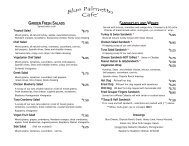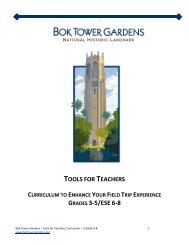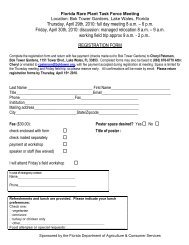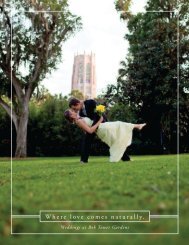masterplan - Bok Tower Gardens
masterplan - Bok Tower Gardens
masterplan - Bok Tower Gardens
Create successful ePaper yourself
Turn your PDF publications into a flip-book with our unique Google optimized e-Paper software.
Our Mission<br />
Th e mission of <strong>Bok</strong> <strong>Tower</strong> <strong>Gardens</strong><br />
is to share Edward <strong>Bok</strong>’s gift of a<br />
beautiful and serene garden with<br />
music, architecture and nature, so<br />
that all who visit will be inspired<br />
by his vision: “Make you the world<br />
a bit better or more beautiful<br />
because you have lived in it.”<br />
Our Vision<br />
Th e vision of <strong>Bok</strong> <strong>Tower</strong> <strong>Gardens</strong><br />
is to off er visitors a unique<br />
experience in a world-class garden<br />
where one can fi nd beauty, peace<br />
and inspiration.<br />
<strong>Gardens</strong> are dynamic and ever-changing. In the short<br />
term, the seasons with their cyclic nature are predictable<br />
and carry a certain reoccurring expectation; the camellia<br />
bloom peaks and fades to return again each year. But in<br />
the long term, change is linear; trees grow ever bigger<br />
casting more shade, shrubs get overgrown and decline.<br />
Th is change can be subtle and hard to predict as the<br />
garden evolves over time. A garden needs replanting and<br />
rethinking as it evolves. For a public garden long term<br />
change not only occurs in the landscape, but also in the programming and how visitors interact and<br />
interpret the garden.<br />
Every so often it is important in a public garden such as ours to step back and circle around to review<br />
where we started, evaluate where we are now and decide where we want to go. In this way the garden<br />
is kept fresh and relevant.<br />
Besides the physical nature of a garden, it is important to fi nancially sustain a garden’s operation.<br />
We therefore undertook a master planning process in the spring of 2011 to address how best we can<br />
move forward to maintain a vibrant garden while ensuring long-term fi nancial sustainability.<br />
Th e 2011 Master Plan is an outgrowth of the Long Range Fundamental Plan adopted by the <strong>Bok</strong><br />
<strong>Tower</strong> <strong>Gardens</strong> board of directors in the fall of 2010. Th is plan is the physical representation of<br />
the vision we have for the <strong>Gardens</strong> over the next 20 to 25 years. Th e plan addresses issues of visitor<br />
accessibility, circulation, interpretation and wayfi nding. Th e plan also outlines ideas for increasing<br />
attendance by broadening our visitor base, revitalizing core areas of the historic garden and the<br />
<strong>Tower</strong>, and positioning <strong>Bok</strong> <strong>Tower</strong> <strong>Gardens</strong> as a world-class garden. Th e ultimate goal of this plan is<br />
to maintain Edward <strong>Bok</strong>’s legacy of the <strong>Gardens</strong> as a gift to the American public.<br />
Th e 2011 Master Plan will not be accomplished all at once. However, as with any long journey it is<br />
essential to have a good map. Please join us as we begin to realize our vision of a world-class garden.<br />
William Burns, Chairman of the Board David Price, President<br />
<strong>Bok</strong> <strong>Tower</strong> <strong>Gardens</strong> <strong>Bok</strong> <strong>Tower</strong> <strong>Gardens</strong>











